①. About Metal injection molding
Metal Injection Molding (MIM) is a manufacturing process used to produce complex, small-to-medium-sized metal parts with high precision and excellent surface finish. It combines principles from both plastic injection molding and powder metallurgy to create metal components with intricate geometries that would be difficult or costly to achieve through traditional machining or forging methods.
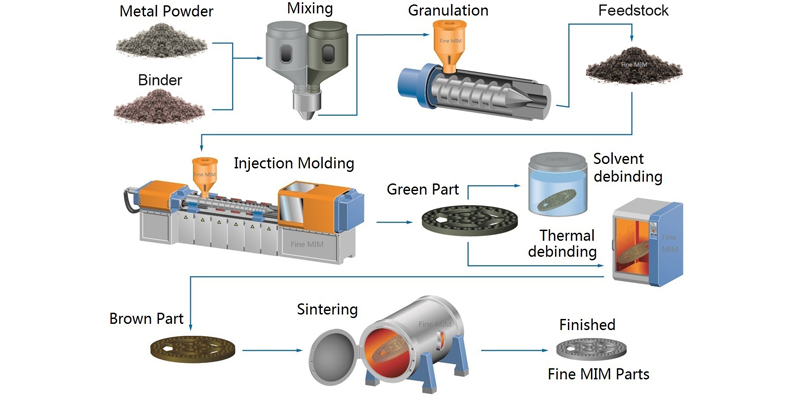
Principles of operation:
1. Feedstock Preparation: The process begins with the preparation of a metal powder feedstock. Typically, fine metal powders (often less than 20 micrometers in size) are mixed with a thermoplastic binder material. This mixture creates a feedstock that is similar in appearance and handling to plastic pellets used in plastic injection molding.
2. Injection Molding: The prepared feedstock is then injected into a mold cavity with the desired part geometry. The mold is typically made of tool steel and is designed to accommodate the shrinkage that occurs during the subsequent steps of the process. The injection molding machine melts the binder, allowing it to flow into the mold and take the shape of the part.
3. Debinding: After molding, the green part (the part with the binder) is removed from the mold. The next step is to remove the binder material from the green part. This is typically done in two stages: first, a low-temperature debinding process removes most of the binder, and then a high-temperature debinding process removes the remainder.
4. Sintering: Once the binder is removed, the remaining metal powder particles are fused together through a sintering process. The green part is heated in a controlled atmosphere furnace to temperatures near or just below the melting point of the metal. This causes the metal particles to bond together, resulting in a dense, solid metal part with the desired mechanical properties.
5. Finishing Operations: Depending on the specific requirements, additional finishing operations such as machining, heat treatment, or surface coating may be performed to achieve the desired final properties and surface finish.
②. Developments in metal injection moulding
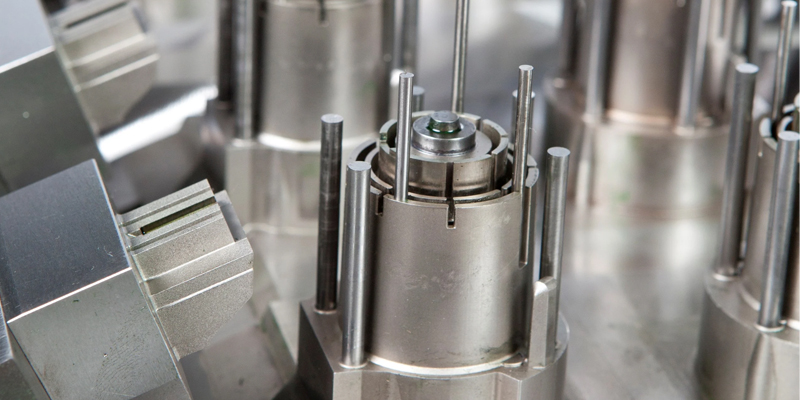
The past and future of Metal Injection Molding (MIM) reflect its evolution from an emerging technology to a well-established and continuously advancing manufacturing process.
Past:
Emergence (1970s-1980s): MIM emerged as a viable manufacturing process in the late 20th century. Early developments focused on improving binder systems and understanding the complexities of debinding and sintering.
Materials Development (1990s): In the 1990s, significant progress was made in developing a wider range of MIM materials, including various metal alloys, superalloys, and even ceramic-metal composites. This expanded the potential applications of MIM.
Widespread Adoption (2000s): MIM gained broader acceptance in industries such as aerospace, automotive, healthcare, and consumer electronics due to its ability to produce high-precision, complex metal parts with cost-efficiency.
Process Refinements (2000s-2010s): Advances in process control, simulation software, and automation improved MIM's efficiency, quality, and repeatability. These refinements led to better part properties and faster production cycles.
Future:
Advanced Materials: The development of new materials with enhanced properties, such as improved strength, conductivity, and heat resistance, will continue to expand the range of applications for MIM. Customized materials tailored to specific industries and applications may become more common.
Nanotechnology: Integration of nanoparticles into MIM materials could lead to parts with superior mechanical properties, such as higher strength, wear resistance, and improved thermal conductivity.
Sustainability: As environmental concerns grow, MIM will likely adopt more sustainable practices, including optimizing energy consumption during debinding and sintering, exploring eco-friendly binders, and reducing waste generation.
Industry Expansion: MIM is expected to penetrate new industries and markets, including the aerospace, defense, and energy sectors. The ability to produce complex, high-performance metal parts with MIM will continue to attract attention.
Customization and Mass Production: MIM's capability for producing complex geometries at scale makes it an ideal candidate for customized, low-volume production runs. This trend will likely continue, enabling more personalized products in various industries.
Digitalization and Industry 4.0: Integration of digital technologies, such as IoT sensors, AI, and data analytics, will enhance process control and quality assurance in MIM production. Real-time monitoring and optimization will become more common.
Miniaturization and Micro-MIM: MIM's expansion into miniaturization and micro-scale manufacturing will enable the creation of tiny, high-precision metal components for use in microelectronics, medical devices, and other emerging technologies.
Hybrid Manufacturing: Combining MIM with other additive manufacturing or subtractive techniques, such as 3D printing or CNC machining, will provide more design flexibility and cost-effectiveness for producing complex parts.
③. Advantages of Metal Injection Molding (MIM)
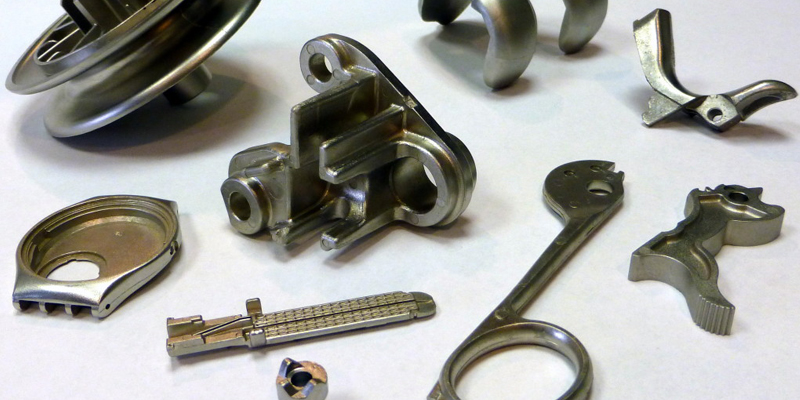
1. Complex Geometries: MIM can produce highly complex and intricate metal parts with fine details, undercuts, and internal features that are challenging or impossible to achieve through conventional machining.
2. High Precision: MIM provides excellent dimensional accuracy and tight tolerances, making it suitable for applications that demand precise and consistent parts.
3. Material Variety: MIM can use a wide range of metal materials, including stainless steel, titanium, alloys, and superalloys, allowing for versatility in material selection to match specific performance requirements.
4. Cost Efficiency: MIM can be cost-effective for the production of complex, small-to-medium-sized metal components, especially when producing in large quantities. It reduces material waste and secondary machining operations.
5. Reduced Post-Processing: Parts produced through MIM often require minimal post-processing, such as surface finishing or deburring, reducing overall production time and cost.
6. Design Freedom: MIM enables designers to create innovative and intricate designs, optimizing part functionality and performance without many of the limitations of traditional manufacturing methods.
7. Consistency: MIM offers high repeatability and consistency in part production, reducing variability and ensuring uniform quality.
④. Disadvantages of Metal Injection Molding (MIM)
1. High Initial Investment: Setting up MIM production facilities and tooling can be expensive, making it less cost-effective for small production runs or prototypes.
2. Material Limitations: While MIM offers a wide range of materials, not all alloys are suitable for the process. Selection is limited to those that can be finely powdered and effectively mixed with binders.
3. Longer Lead Times: MIM can have longer lead times compared to other manufacturing processes due to the multiple steps involved, including debinding and sintering.
4. Size Constraints: MIM is best suited for small-to-medium-sized parts. Producing large components through MIM can be challenging and costly.
5. Tool Wear: The abrasive nature of metal powders used in MIM can lead to tool wear, which may necessitate frequent tool replacement and maintenance.
6. Complex Process Control: Achieving the desired properties in MIM parts requires precise control of the debinding and sintering processes, which can be technically demanding.
7. Limited Mechanical Properties: While MIM parts can exhibit excellent mechanical properties, they may not be on par with parts produced through traditional metallurgical processes, especially for critical aerospace or automotive applications.
⑤. Application of metal injection molding
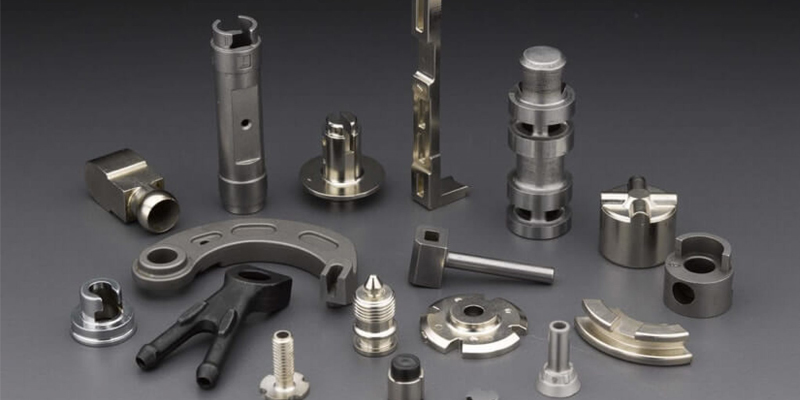
Medical Devices: MIM is extensively used in the production of medical components such as surgical instruments, dental implants, orthodontic brackets, and various implantable devices due to its biocompatibility and precision.
Aerospace and Defense: The aerospace and defense industries use MIM for producing components like turbine blades, aircraft brackets, firearm parts, and missile guidance system components, where lightweight and high-strength materials are crucial.
Automotive: MIM is employed for manufacturing automotive components like transmission parts, fuel injection nozzles, sensors, and engine components, where tight tolerances and high durability are essential.
Consumer Electronics: MIM is used for small, complex parts in consumer electronics, including connectors, micro switches, and hinges, where miniaturization and precision are critical.
Firearms: Many firearm manufacturers use MIM to produce components like trigger assemblies, hammers, and sears due to its ability to create intricate shapes and maintain tight tolerances.
Industrial and Tooling: MIM produces parts such as gears, cams, and inserts for injection molds and die-casting molds, improving wear resistance and reducing maintenance.
Telecommunications: MIM is employed for manufacturing connectors, housings, and RF/microwave components in telecommunications equipment, where electrical conductivity and precision are essential.
Electronics: MIM is used to create heat sinks, shielding components, and connectors in various electronic devices to improve thermal management and electrical conductivity.
Oil and Gas: MIM parts, including valve components, sensor housings, and nozzles, are used in the oil and gas industry, where resistance to harsh environments and corrosion is vital.
Fire Sprinkler Systems: The complex and precise components used in fire sprinkler systems are often produced using MIM technology.
Jewelry and Fashion Accessories: MIM allows for the creation of intricate and detailed metal jewelry, watch components, and fashion accessories with complex designs.
Tool Components: MIM is used to produce tool components like cutting inserts, drills, and blades, offering high wear resistance and precision.
Orthopedic and Orthodontic Devices: MIM is used in the production of orthopedic implants, bone screws, and orthodontic brackets due to its biocompatibility and precision.
Fire Safety Equipment: MIM is employed in the manufacturing of fire safety equipment components such as sprinkler heads and valve parts.
Sporting Goods: MIM is used to produce parts for sporting equipment like golf club heads, firearm components for competitive shooting, and archery components.
⑥. When is metal injection moulding required?
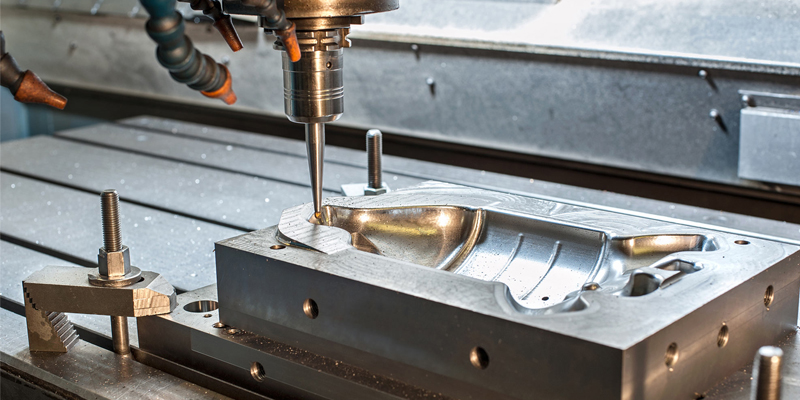
There are situations where MIM may be the best or most practical choice, and it may even be necessary due to specific requirements or constraints:
l Complex Geometries: MIM excels when you need to produce metal parts with highly complex geometries, intricate details, and internal features that are challenging or impossible to achieve through other methods.
l Miniaturization and Micro-MIM: For micro-scale or miniature metal components, MIM may be the only viable option, as traditional manufacturing processes often struggle to produce such small and intricate parts with precision.
l High Precision and Tight Tolerances: When your application demands exceptionally tight tolerances, excellent dimensional accuracy, and repeatability, MIM is a strong contender. It's capable of achieving precision that rivals or surpasses other methods.
l Material Variety and Custom Alloys: If your project requires specific materials or custom alloys that are readily available in powdered form, MIM offers the flexibility to use a wide range of metal materials, including exotic alloys and customized blends.
l Reduced Post-Processing: When minimizing secondary operations like machining, grinding, or finishing is essential to meet cost or time constraints, MIM's ability to produce near-net-shape parts with minimal post-processing can be a key advantage.
l Biocompatibility: In the medical and dental fields, where biocompatible materials are crucial for implants, surgical instruments, or orthodontic devices, MIM may be a necessary choice due to its ability to produce biocompatible parts.
l Cost Efficiency for High Volumes: When you need to produce a large number of small-to-medium-sized metal parts and achieve cost savings compared to traditional manufacturing methods, MIM may be the most cost-effective option.
l Design Freedom and Innovation: MIM allows for greater design freedom, making it a valuable choice when you want to innovate and create complex, unique, or customized metal parts.
l Consistency and Uniformity: In industries where maintaining consistent part quality across production runs is a critical requirement, MIM's high level of repeatability can be essential.
l Customization and Prototyping: If you require customized or prototype metal parts, MIM can be a practical option for small production runs and rapid development.
Get Metal Injection Molding Solution & Quote Now